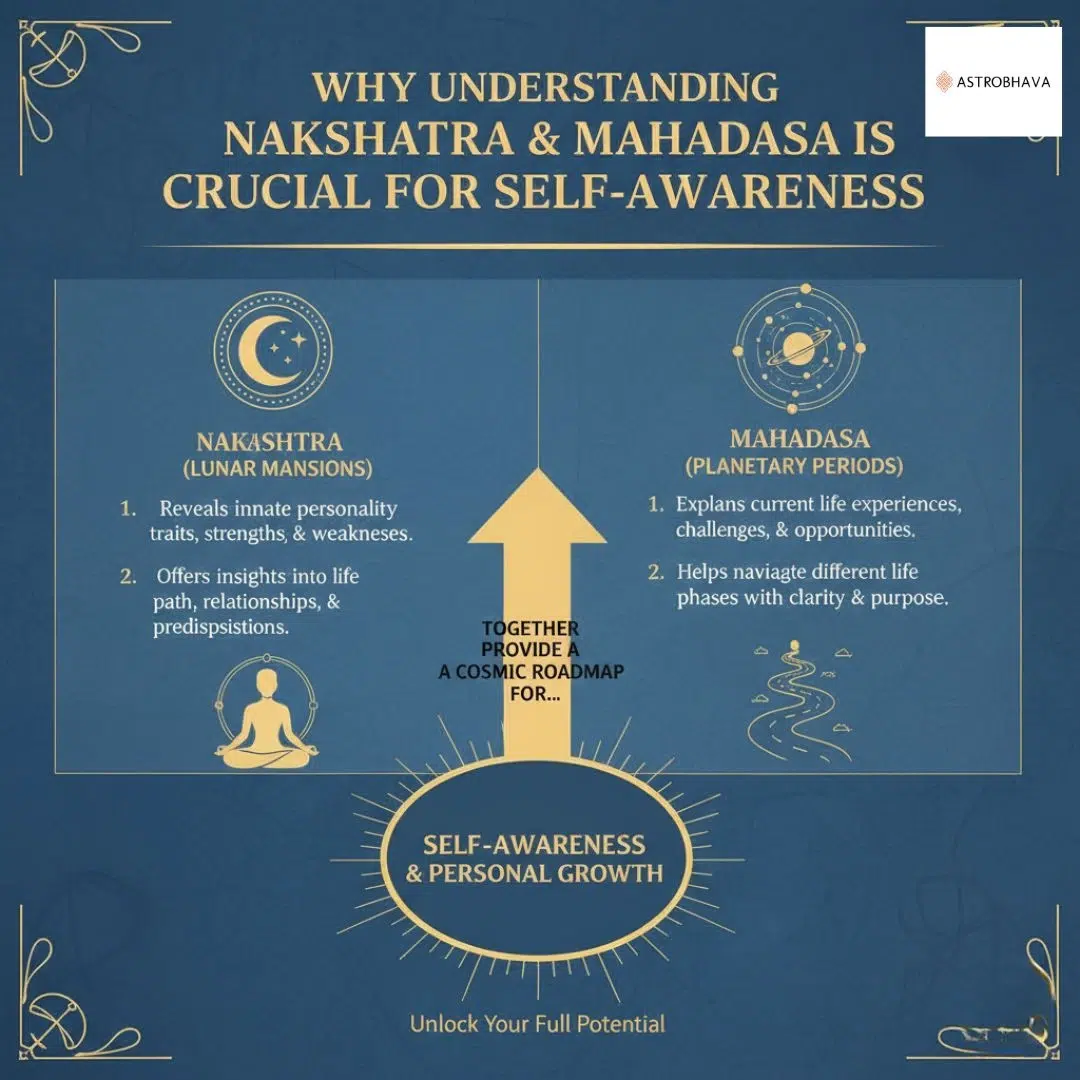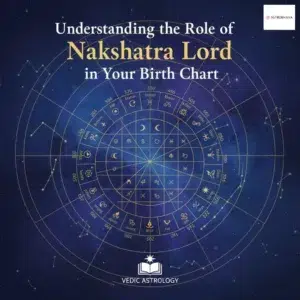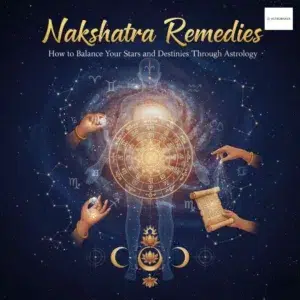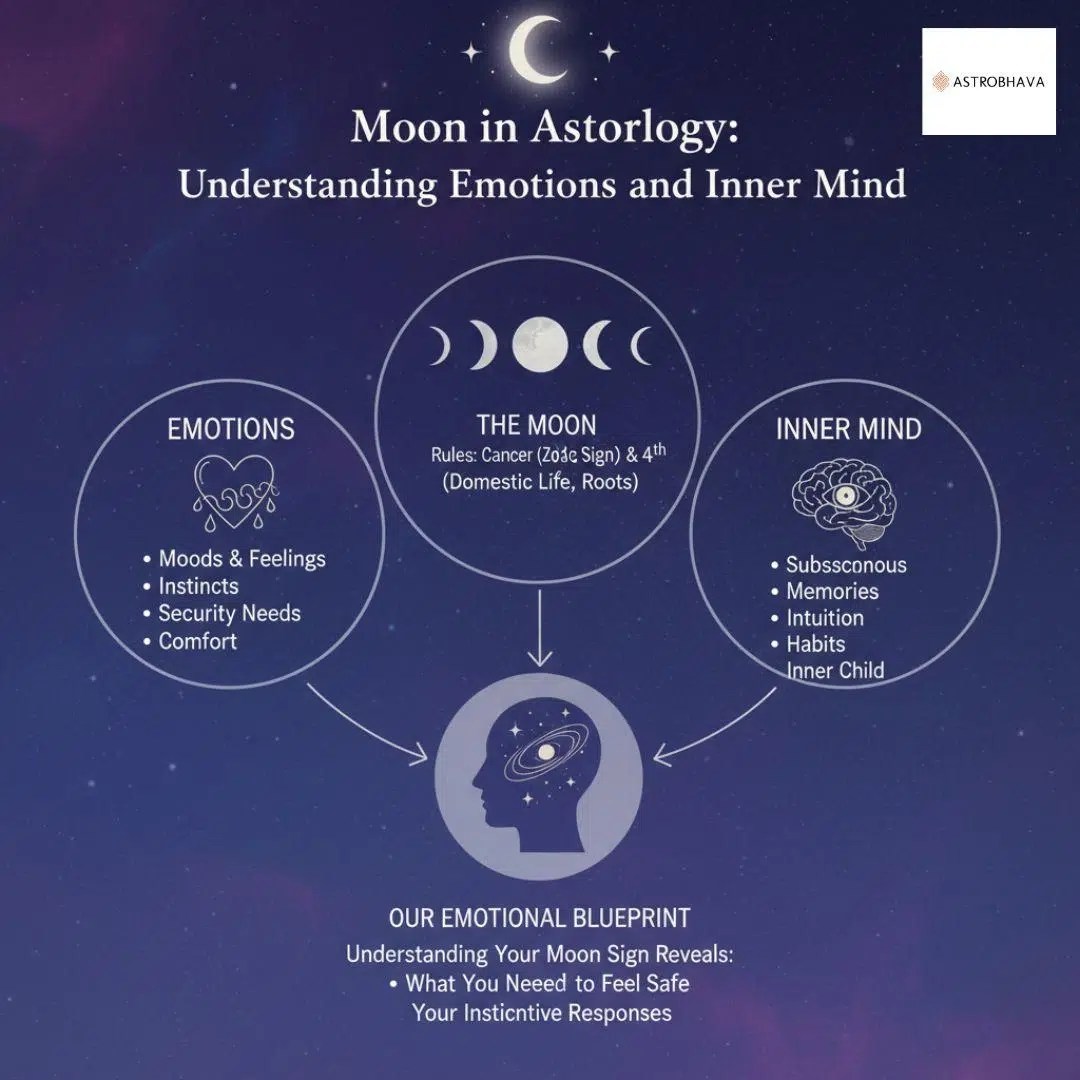What Is the Connection Between Nakshatra and Mahadasha in Vedic Astrology?
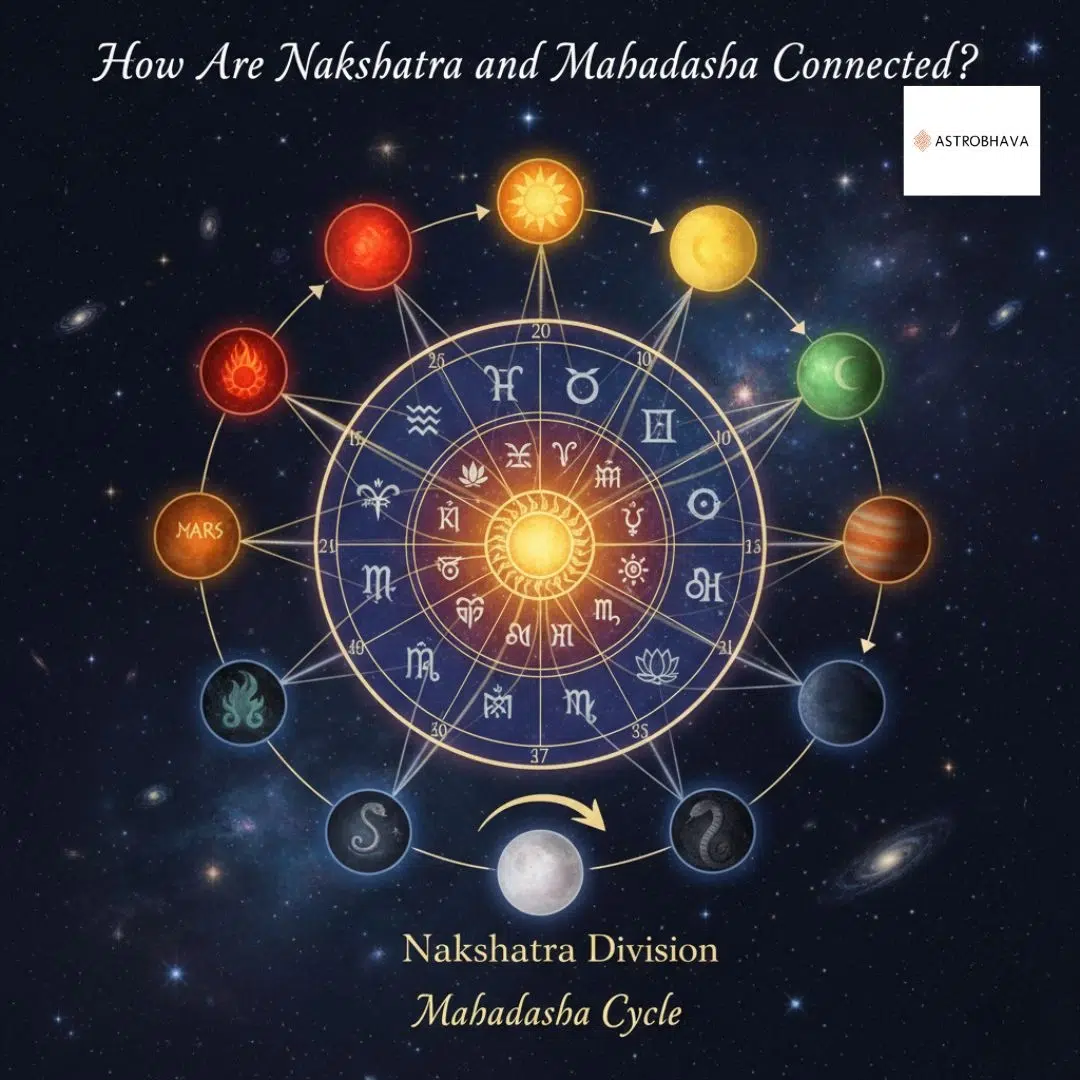
In Vedic astrology, every soul’s journey is guided by an intricate celestial pattern—the motion of planets and the constellation (Nakshatra) under which one is born. Together, these two—Nakshatra and Mahadasha—act as cosmic storytellers that unfold your life’s script, influencing your personality, relationships, health, and destiny.
Think of your Nakshatra as your “birth star,” the zodiacal mansion the Moon occupied when you were born. It reveals your innate qualities, emotional responses, and karmic patterns. Meanwhile, your Mahadasha (planetary period) functions as the “timekeeper” of destiny, activating planetary influences at specific intervals in your life.
Whether you’re wondering why life feels turbulent during a certain period or why success peaks unexpectedly, understanding the link between Nakshatra and Mahadasha brings powerful insights into your karma and purpose.
What Does “Nakshatra” Really Mean in Vedic Astrology?
Nakshatras are 27 (sometimes 28) cosmic divisions of the zodiac, each spanning 13°20’. These star clusters go far beyond the 12 zodiac signs, capturing subtle emotional and spiritual vibrations.
Every Nakshatra has:
- A ruling deity (symbolizing divine archetypes)
- A planetary ruler (governing the Mahadasha pattern)
- Elements (fire, water, air, earth)
- Symbolic qualities (courage, wisdom, nurturing, transformation)
For example:
- Ashwini Nakshatra, ruled by Ketu, indicates healing, beginnings, and speed.
- Rohini Nakshatra, ruled by Moon, reflects creativity and beauty.
- Magha Nakshatra, ruled by Ketu, connects to ancestors, royalty, and authority.
- Revati Nakshatra, ruled by Mercury, symbolizes compassion, travel, and completion.
Your birth Nakshatra offers a signature of your emotional energy and karmic potential. It sets the tone for how planetary periods (Mahadashas) will express themselves in your life.
Why Is Mahadasha Important in Vedic Astrology?
Mahadasha (major planetary period) is the first layer of the Vimshottari Dasha system. It divides your life into sequential planetary periods ruled by nine planets—Sun, Moon, Mars, Mercury, Jupiter, Venus, Saturn, Rahu, and Ketu—with fixed durations totaling 120 years.
Each Mahadasha brings a unique flavor:
- Sun Mahadasha (6 years): Leadership, authority, health, ego development
- Moon Mahadasha (10 years): Emotions, relationships, domestic happiness
- Mars Mahadasha (7 years): Drive, courage, conflict resolution
- Mercury Mahadasha (17 years): Communication, intellect, trade
- Jupiter Mahadasha (16 years): Wisdom, education, prosperity
- Venus Mahadasha (20 years): Love, comforts, creativity
- Saturn Mahadasha (19 years): Discipline, karma, responsibility
- Rahu Mahadasha (18 years): Sudden changes, obsessions, innovation
- Ketu Mahadasha (7 years): Detachment, spirituality, karmic closure
Each phase acts like a “season of life,” bringing growth in certain spheres while challenging others.
How Are Nakshatra and Mahadasha Connected?
The magical link lies in the Nakshatra where your Moon is placed at birth. The ruling planet of that Nakshatra determines your first Mahadasha.
For example:
- If your Moon is in Ashwini Nakshatra (ruled by Ketu), your life starts with Ketu Mahadasha.
- If it’s in Mrigashira Nakshatra (ruled by Mars), Mars Mahadasha comes first.
This planetary sequence continues in a fixed order according to the Vimshottari system. Thus, your Nakshatra dictates the timeline of your planetary influences—explaining why individuals born on the same date but under different Nakshatras experience distinct life trajectories.
What Does Your Birth Nakshatra Reveal About Your First Mahadasha?
Your birth Nakshatra defines the entry vibration of your life’s destiny. Each planet carries its karma and expression through the Nakshatra’s energy.
- Ketu-ruled Nakshatras (Ashwini, Magha, Mula): Start with detachment, healing, and ancestral karma.
- Venus-ruled Nakshatras (Bharani, Purva Phalguni, Purva Ashadha): Begin with desires, relationships, and creative gifts.
- Sun-ruled Nakshatras (Krittika, Uttara Phalguni, Uttara Ashadha): Early experiences of independence and authority.
- Moon-ruled Nakshatras (Rohini, Hasta, Shravana): Emotional growth and deep family bonds define the early phase.
- Mars-ruled Nakshatras (Mrigashira, Chitra, Dhanishta): Energy, conflict, and action shape early transformation.
- Rahu-ruled Nakshatras (Ardra, Swati, Shatabhisha): Instability, innovation, and material ambition start early.
- Jupiter-ruled Nakshatras (Punarvasu, Vishakha, Purva Bhadrapada): Faith and wisdom develop through expansion.
- Saturn-ruled Nakshatras (Pushya, Anuradha, Uttara Bhadrapada): Discipline, patience, and duty form the foundation.
- Mercury-ruled Nakshatras (Ashlesha, Jyeshtha, Revati): Learning, adaptability, and communication begin early.
Thus, your Nakshatra not only reflects your nature but also triggers the cosmic timeline for your Mahadasha sequence.
How Does Mahadasha Influence Different Life Areas?
Each Mahadasha activates the planet’s role in your birth chart. Its impact depends on the planet’s placement, conjunctions, aspects, and strength (Shadbala).
- Career:
A Mercury or Sun Mahadasha often accelerates professional growth, whereas a Saturn Mahadasha brings long-term stability through discipline. - Relationships:
The periods of Venus and the Moon heighten emotional and romantic experiences. Rahu can create illusions or unconventional love experiences, while Ketu may induce detachment. - Health:
Mars and Saturn may challenge vitality if ill-placed. Jupiter and Moon Mahadashas generally promote well-being. - Spiritual Growth:
Ketu Mahadasha pushes detachment from material life, while Jupiter enhances wisdom and inner expansion.
How Can You Use Nakshatra and Mahadasha to Plan Major Life Decisions?
Here are the key points on “How Can You Use Nakshatra and Mahadasha to Plan Major Life Decisions?”:
- Analyze your Moon’s Nakshatra at birth to see which planet’s Mahadasha starts your life journey; this sets the main tone for career, marriage, and key changes.
- Match major life decisions (like marriage, relocation, investments) with favorable Mahadasha and Antardasha periods for smoother outcomes and greater success.
- Select timings (Muhurta) for marriage, childbirth, property buying, or career moves based on supportive Mahadasha/Nakshatra energies and their ruling deities.
- A Nakshatra ruled by Venus (Bharani, Purva Phalguni) and a Venus Mahadasha may favor relationships, beauty, and creative projects.
- A Saturn-ruled period and practical Nakshatra (Pushya, Anuradha) are ideal for career consolidation, responsibility, discipline, and real estate investments.
- For higher studies or intellectual growth, use Mercury Antardasha and Nakshatras known for intelligence (Ashlesha, Revati).
- When challenging Mahadashas or intense Nakshatras are active, adjust your plans, adopt remedies, or postpone risky decisions for better alignment.
- Use Nakshatra-based Dasha timelines to emotionally prepare for life themes, anticipate transitions, and manage expectations during both opportunity and adversity.
These strategies empower you to navigate life proactively and in harmony with cosmic timing.
Can Combining Nakshatra and Mahadasha Predictions Give More Accurate Readings?
Absolutely. When Nakshatra and Mahadasha are analyzed together, they provide deeper personalization than general astrological readings.
For instance:
- A Venus-ruled Nakshatra native undergoing Venus Mahadasha may find creative success and harmony.
- A Mars Nakshatra person entering Saturn Mahadasha could experience karmic challenges leading to maturity.
- A Rahu Nakshatra native in Jupiter Mahadasha might shift from material ambitions to spiritual expansion.
Astrologers often overlay Nakshatra-based Dasha sequence with planetary transits and Navamsa chart insights for fine-grained predictions.
How Can You Find Your Nakshatra and Mahadasha?
You can find your Nakshatra using your exact birth time, date, and location. Tools like online Vedic astrology calculators or consultations with qualified astrologers can tell you which Nakshatra your Moon occupies.
Once you know your Nakshatra:
- Identify its ruling planet.
- Use the Vimshottari Dasha sequence to find your current Mahadasha period.
- Track Antardasha (sub-periods) to understand micro-level planetary effects.
For instance, if your Mahadasha is Moon, but your Antardasha is Saturn, you’ll feel Moon’s emotions blended with Saturn’s structure—creating a mix of sensitivity and responsibility.
What Are the Remedies to Balance Challenging Mahadasha Periods?
Astrologers recommend specific remedies to harmonize planetary energies during tough Mahadasha phases:
- Mantras: Chant planetary mantras (e.g., “Om Shram Shreem Shroum Sah Chandraya Namah” for Moon).
- Gemstones: Wear gemstones like Pearl (Moon), Ruby (Sun), or Blue Sapphire (Saturn) after proper consultation.
- Charity and Fasting: Offer food, clothes, or donations aligned with planetary beneficiaries.
- Meditation and Yoga: Align chakras and balance emotions through regular practice.
- Rituals and Pujas: Perform Navagraha puja or Nakshatra-specific havans during difficult dashas.
These remedies don’t eliminate karma but can ease resistance and improve your awareness.
Why Understanding Nakshatra and Mahadasha Is Crucial for Self-Awareness
Knowing your Nakshatra and Mahadasha helps you:
- Recognize patterns in success and failure.
- Time your decisions for career, marriage, or investments.
- Understand emotional cycles and karmic triggers.
- Enhance your spiritual growth by aligning with cosmic timing.
When you become aware of which planetary energy dominates your present period, you can align your goals rather than resist fate.
FAQs About Nakshatra and Mahadasha
- How long does one Mahadasha last?
Each Mahadasha lasts between 6 and 20 years, depending on the planet—Sun (6 years), Moon (10 years), Mars (7 years), etc. —following a 120-year Vimshottari cycle. - Does Mahadasha repeat in a lifetime?
Typically, only partial repetitions occur depending on the lifespan. Each new cycle follows the fixed planetary order, beginning from your birth Nakshatra ruler. - Which Mahadasha is considered most favorable?
No Mahadasha is universally “good” or “bad.” Its result depends on your birth chart’s planetary placements. For example, Jupiter Mahadasha often favors growth, but only if Jupiter is well-placed. - Can remedies change Mahadasha outcomes?
Remedies can balance difficult planetary energies but cannot entirely alter karmic results. They help you act consciously and minimize struggles. - How do Antardasha and Mahadasha differ?
Mahadasha represents the major planetary influence, while Antardasha (sub-dasha) fine-tunes results within that period, creating different life phases under one main planetary ruler.
Conclusion: How Can You Align With Your Nakshatra and Mahadasha for Success?
Aligning with your Nakshatra and Mahadasha is about understanding and flowing with cosmic timing instead of resisting it. Each Nakshatra and Mahadasha sequence is tailored to your unique karmic journey, setting up not just what happens but how you respond and grow. When you know which planetary energy is active and the emotional patterns of your Nakshatra, you become more conscious of your strengths, challenges, and opportunities.
Proactively leveraging this knowledge helps you make timely decisions—whether in relationships, career, or personal growth—and seek remedies or strategies when facing intense periods. With awareness and aligned actions, you can use your planetary cycles as a roadmap, transforming uncertainty into foresight, stress into preparedness, and resistance into lasting success.
Curious about your Nakshatra and Mahadasha? Get a personalized birth chart reading with AstroBhava experts to decode your destiny and align with cosmic timing.
Related posts:
Categories
- 10th House meaning
- 12th house astrology
- 12th House Moon meaning
- 1st house in astrology
- 2025 astrology
- 2025 festivals
- 2025 planetary movements
- 27 nakshatras
- 2nd house astrology finance
- 2nd house in astrology
- 2nd house in astrology explained
- 3rd house in astrology
- 9th house moon astrology
- Antardasha
- aries personality
- aries traits
- aries zodiac sign
- ascendant in astrology
- astro guide
- astro predictions 2025
- astro remedies
- astro tips
- Astrobhava
- Astrobhava astrology
- Astrobhava blog
- astrological effects
- astrological guidance
- astrological love compatibility
- Astrological love languages
- Astrological Remedies
- astrology
- astrology 2025
- astrology 2nd house meaning
- astrology benefits
- astrology calculator
- astrology career path
- astrology career prediction
- astrology compatibility
- astrology consultation
- astrology for business
- astrology for wealth
- astrology gemstones
- astrology guide
- Astrology Guides
- astrology houses
- astrology insights
- astrology love guide
- astrology lucky color
- astrology predictions
- astrology remedies
- astrology remedies for job
- Astrology Remedies for Wellness
- astrology rituals
- astrology solutions
- astrology soulmate signs
- astrology sun planet
- astrology tips
- auspicious yogas
- Bhagavad Gita Jayanti
- birth chart
- birth chart analysis
- birth chart reading
- birth star matching
- business astrology
- business partnership astrology
- business success astrology
- career astrology
- Career Astrology & Personal Growth
- career astrology remedies
- career by nakshatra
- career growth remedies
- career stagnation remedies
- color astrology
- communication astrology
- compatibility chart
- Cosmology
- Dasha
- dasha period calculator
- Dasha system
- divine blessings
- dosha
- dosha remedies
- dreams interpretation
- dreams meaning
- Ekadashi benefits
- Ekadashi rituals
- Ekadashi vrat
- emotional astrology
- emotional compatibility
- emotional growth astrology
- emotional healing
- entrepreneurial astrology
- Festivals & Vedic Rituals
- financial astrology
- fire sign aries
- first house meaning
- Gaja Kesari Yoga
- Gaja Kesari Yoga benefits
- gemstone astrology
- gemstone benefits
- Gita Jayanti 2025 astrology
- Gita Jayanti astrology
- hindu astrology
- Hindu calendar 2025
- Hindu fasting
- Hindu Festivals
- Hindu festivals 2025
- Hindu festivals astrology
- hindu rituals
- Homa and Fire Rituals (Yagna)
- horoscope
- horoscope analysis
- horoscope colors
- horoscope correction
- horoscope guide
- horoscope matching
- horoscope reading
- horoscope remedies
- horoscope yoga benefits
- Indian astrology
- insightful trade
- Japa
- job astrology
- Jupiter Moon yoga
- kundli matching
- kundli reading
- lagna in astrology
- Latcharchana remedies
- list of 27 nakshatras
- lord of nakshatra
- love astrology
- love horoscope
- love match astrology
- lucky color for zodiac signs
- lucky gemstones
- lunar rituals
- lunar signs
- Mahadasha
- Mahadasha Calculator
- mahadasha effects
- Mahadasha periods
- Mahadasha prediction
- Mahadasha remedies
- mahadasha results
- Mantra
- Margashirsha puja
- Margashirsha Purnima 2025
- Margashirsha rituals
- Marriage Auspicious Day
- marriage matching
- match making astrology
- Mercury planet
- Mercury Retrograde
- Mercury Retrograde dates
- Mercury Retrograde effects
- Moon and profession
- Moon astrology
- Moon astrology insights
- Moon effects in astrology
- Moon house meaning
- Moon in 10th House
- Moon in 11th House
- Moon in 12th House
- Moon in 6th House
- Moon in 6th House effects
- Moon in 6th House remedies
- Moon in 7th House
- Moon in 7th House astrology
- Moon in 7th House effects
- Moon in 7th House love
- Moon in 7th House marriage
- Moon in 7th House meaning
- Moon in 7th House remedies
- Moon in 8th House
- moon in 8th house love
- moon in 8th house marriage
- moon in 9th house
- moon in 9th house effects
- Moon in Astrology
- moon in eighth house effects
- Moon in Eleventh House meaning
- moon in ninth house meaning
- Moon in Sixth House astrology
- Moon in tenth house career
- moon meaning
- Moon placement
- Moon placement in 7th House
- nadi astrology
- Nakshatra and Mahadasha
- nakshatra astrology
- nakshatra calculator
- nakshatra career guide
- nakshatra characteristics
- Nakshatra compatibility
- nakshatra guide
- nakshatra healing
- nakshatra job compatibility
- Nakshatra Lord
- nakshatra matching for marriage
- nakshatra meaning
- Nakshatra Remedies
- nakshatra ruler
- nakshatras
- natal chart analysis
- numerology
- online astrology tool
- Panchami Festival
- partnership compatibility
- past karma
- past karma astrology
- personality in astrology
- Pilgrimage
- planetary dasha calculator
- planetary insights
- planetary mahadasha
- planetary periods
- planetary remedies
- planetary retrograde
- planetary transits 2025
- planets houses
- positivity rituals
- powerful astrology solutions
- Progency
- Puja & Rituals
- puja remedies
- Purnima 2025
- relationship astrology
- Relationships
- remove career blockages
- retrograde meaning
- rudra puja
- Rudraksha and gemstone
- sankranti 2025
- sankranti rituals
- Saphala Ekadashi 2025
- Saturn japa
- Saturn remedies
- Shani dosha
- Shani japa benefits
- Shani mantra
- Spiritual Astrology
- spiritual benefits
- spiritual growth
- spiritual healing
- Spiritual Practices and Chanting
- spiritual remedies
- Spiritual Rituals and Personal Empowerment
- spiritual significance
- Spiritual Tools & Personal Growth
- Spiritual Wellness and Protection
- Spirituality and Rituals
- Spirituality or Vedic Rituals
- star sign compatibility
- sun and zodiac signs
- Sun in Astrology
- sun in horoscope
- sun planet effects
- sun planet meaning
- sun power in astrology
- temple rituals
- twin flame astrology
- Twin Flame Astrology Signs
- twin flame compatibility
- twin flame signs
- Utpanna Ekadashi 2025
- Utpanna Ekadashi dates
- Utpanna Ekadashi rituals
- Utpanna Ekadashi significance
- Vastu Tips
- Vedic Astrology
- vedic astrology tools
- Vedic remedies
- Vivaah Panchami
- Vivaah Panchami Puja
- Vivaah Panchami Rituals
- Vivaah Panchami Significance
- vrat guide
- vrischik sankranti puja
- vrishchik rashi
- Vrishchik sankranti
- yantras
- yoga effects
- zodiac astrology
- zodiac colors meaning
- zodiac compatibility
- zodiac lucky colors
- zodiac moon traits
- zodiac relationships
- Zodiac Signs


